[ad_1]
Raising backyard chickens is gaining in popularity. But before you bring home those cute fluffy chicks from the feed store, there are a few things you need to know. We’ll help you cut through the online information avalanche and prep a home for resilient, healthy birds.
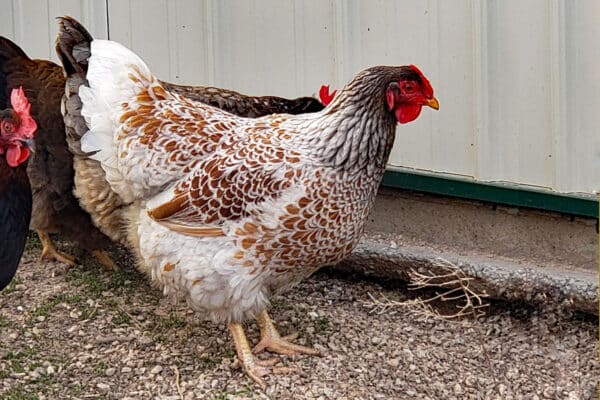
Raising Chickens – Things to Consider
Before you start your flock, you need to decide whether you want birds for egg production, meat birds, or dual purpose birds. Then, you need to determine the number of chickens you want to raise, and whether to start with fertilized eggs or baby chicks. Finally, you need to cover the basics – shelter, food, and clean water.
Make sure Chickens are Legal in your Area
Check with local ordinances to make sure it’s okay to raise chickens in your area. Some municipalities only allow a certain number of birds, or allow laying hens but not roosters.
Do you want eggs, meat, or both?
The taste of home raised eggs easily beats the flavor of store bought eggs. Plus, you know they’re fresh, unlike supermarket eggs, which may be up to 2 months old. Many first time chicken owners start with laying hens because they don’t want to do butchering.
If you’re thinking about dual purpose birds, you may want to try cooking up a dual purpose bird from a local producer first. Chickens marketed as dual purpose mature more slowly than those marketed for meat. The processed birds look much different than those found in the grocery store. They are leaner, and the meat is firmer.
We’ll be focusing on egg laying hens for this article, but you can learn more about meat chickens here.
Some of the best egg layers are Leghorns, Red Stars, Rhode Island Reds, Black Australorps, and Whiting True Blues . Check out Best Laying Hens for a comparison of different chicken breeds.
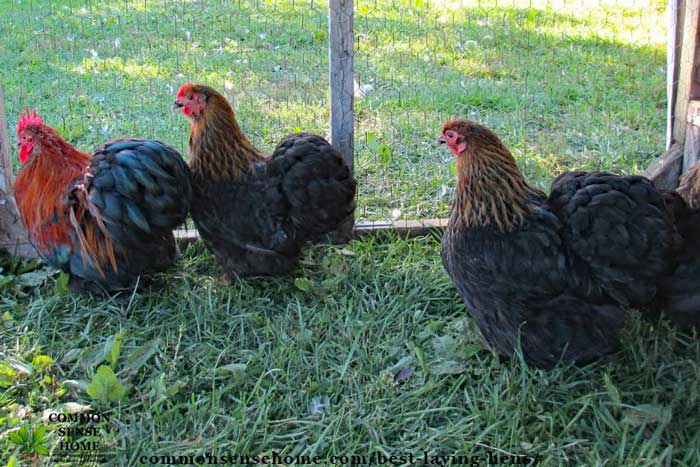
How Many Chickens Should you Raise?
Chickens like hanging out with other chickens, so it’s best to have at least three birds. On average, a single laying hen can produce around 250-300 eggs per year. For a family of four, who might consume roughly a dozen eggs per week, a flock of 4-6 hens would be sufficient. You do not need a rooster to get eggs.
Female chickens (hens) ovulates a new yolk every 24-26 hours, after laying an egg. Eggs need 26 hours to fully form, so hens lay later and later each day. Eventually they lay too late in the day to signal ovulation, and they skip a day. This is why your hens don’t lay eggs every single day.
Start with Chicks or Mature Birds Instead of Eggs
I highly recommend starting with sexed chicks for your first flock. When you get female chicks (pullets), you don’t have to worry about butchering or rehoming roosters. Incubating eggs can be fun, but may also be frustrating.
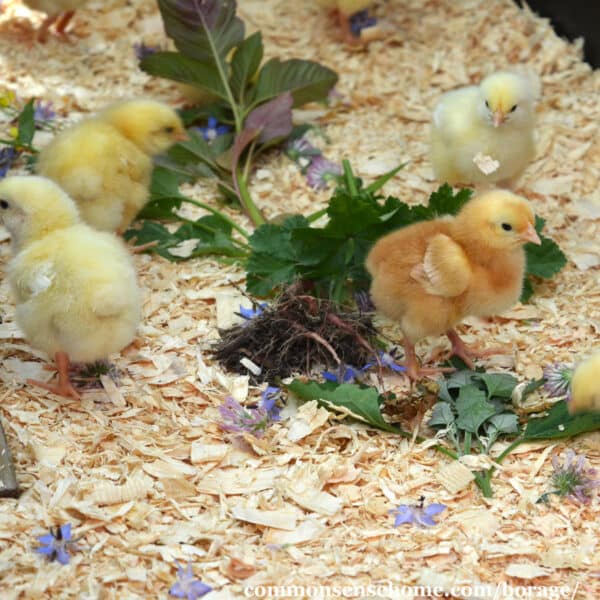
Check with your local feed stores in spring. Some have live chick displays where you can pick your chicks in store. Others allow you to order chicks and pick them up in store. You can also mail order chicks from online nurseries.
Sometimes you’ll find mature laying hens for sale locally when people need to downsize their flocks. Make sure to check bird health and age. Hens may live for 6-8 years, but peak production occurs during their first two years. My grandmother raised chickens to sell eggs, and she replaced her flock each year to keep production high.
Shelter, Food, and Clean Water
Just like people or pets, chickens need shelter, food, and clean water. The needs of chicks are different than the needs of adult chickens.
Shelter – Begin with a Brooder, End with a Coop
When you bring those baby chicks home, they can’t go straight into a coop without some special preps. Instead, you need to start with brooder space.
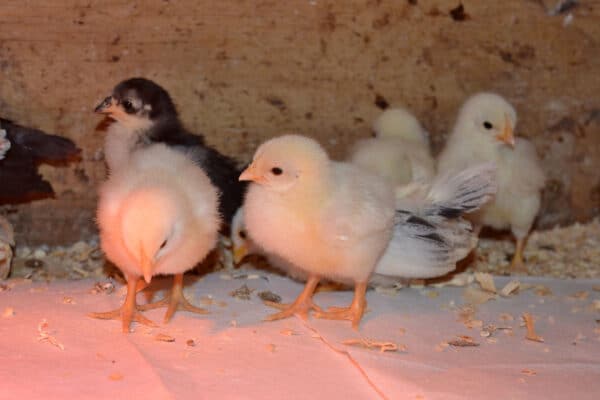
A chicken brooder is an enclosure or space specifically designed to provide warmth and shelter to newly hatched chicks. Brooders nurture chicks until they can regulate their body temperature and thrive independently in a coop or outdoors.
Chicks need extra heat for 3-6 weeks, depending on the environment. For the first week, start with a warm area kept at around 95°F (35°C). You can lower the temperature around 5 degrees per week, until they are fully feathered at around 6 weeks.
To provide heat, you can use a heat lamp or radiant heater specifically designed for chicks. For small groups of chicks, you can even use a hot water bottle. The radiant heaters are more expensive, but safer than heat lamps.
We keep our chicks inside in a large cardboard box for about a week before moving them out to the coop. Some people raise them in totes, or large water troughs, or a protected area in the coop.
Whatever you choose, make sure the chicks are protected from predators and drafts. Avoid using sawdust for bedding, as the chicks may eat it. Larger flake bedding or pellet bedding is better.
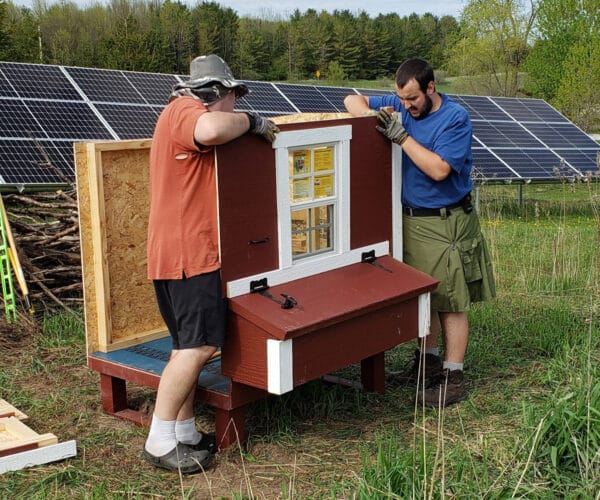
For raising chickens as they grow out of chick stage, your chicken coop needs:
- protection from predators
- a place to roost
- nesting boxes (for layers)
- a dust bath
- room to move around
Ideally, each chicken should have at least 2-3 square feet of coop space, and 8-10 square feet of outdoor space to roam.
You can convert an existing building, use a chicken tractor, buy a coop, or build a coop. Easy Coops has DIY chicken coop plans for flocks of all sizes.
Feeding Your Flock
The easiest way to make sure your chickens get the nutrients they need is to use commercial chicken feed. Like their shelter, adults need something a little different than chicks.
Chicks are growing fast, so their feed has more protein. Look for “starter/grower feed” for the fluffy bundles. Once they are old enough to lay eggs (around 20 weeks), transition to layer feed.
Layer feed has more calcium to help with egg production. We also offer crushed oyster shells and/or crushed egg shells free choice for calcium and grit.
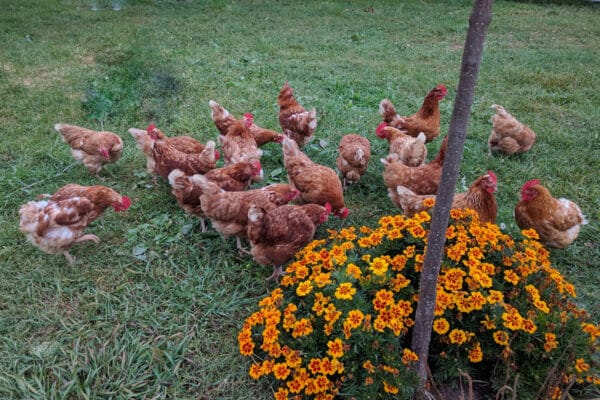
Make sure your chickens get outside time to free range or in a run with access to forage. This will help reduce your food costs. Chickens like garden scraps and table scraps, too. If you want to mix your own balanced flock ration, check out The Small Scale Poultry Flock for recipes.
Don’t go overboard with rich treats like mealworms or soldier fly larvae. Too many treats can lead to health issues. See “What to Feed Chickens” for more details on safe foods.
Don’t let the chickens in the garden during the growing season. They like to dig and take a taste of almost everything. Instead, put them on cleanup duty once the season wraps up, or let them dig in the beds before planting.
Provide food in a trough, bowl, commercial feeder, or DIY feeder. Chickens love to dig and scratch, so it can be helpful to have an elevated feeder to keep the bedding out of the food. Some people suggest keeping food out of the coop for cleanliness, but our girls sometimes get stuck inside due to the cold weather. Not feeding them inside is not an option.
Clean Water
Fresh, clean water is critical for flock health. Commercial waterers are easy to use, easy to clean, and come in several sizes.
We like to add a little raw apple cider vinegar to our flock water, so we use plastic waterers. (Vinegar will corrode metal waterers.) I prefer a waterer that has a large enough opening that I can get my hand inside to scrub it.
In summer, you made need an extra waterer, or even a kiddy pool to help the flock deal with extreme temps. In winter, make sure their water doesn’t freeze. We swap out waterers once or twice a day, as needed, or use a heated waterer. There are plug in poultry waterers, or you can use a heated dog dish.
How soon will I get eggs?
One of the best parts of raising chickens is the eggs, but when do they start? Hens will lay eggs at around 20 weeks old (about 4 1/2 months). They will continue laying for years, taking breaks for molting and low light days.
Chickens need about 14 to 16 hours of daylight to stimulate egg production. This maximizes egg production near summer solstice, when the days are long and warm. That way, chicks hatch in spring and have time to mature while it’s warm.
If you get your chicks later in the season, and they hit the 20 week mark in the middle of winter, they may not start laying until closer to spring.

To increase egg production, some people add light to the coop. If you want to add light, use a light on a timer in the early morning, so the birds have 15 hours of light.
We personally don’t add light in the coop, because I figure the birds need some rest. The birds typically molt when the days get shorter, too, so they need energy for new feathers.
If more eggs is the priority, opt for sex link chickens bred to be heavy layers. Red stars, Red Comets, ISA browns are some of crosses that are bred for maximum egg production. These birds produce an amazing number of eggs, without supplemental lighting.
See also: “When do chickens start laying eggs? (And why do they stop?)“
Is it cheaper to raise chickens or buy eggs?
Odds are that you can buy eggs cheaper than you can raise chickens. That said, I prefer the flavor and freshness of home raised eggs. I also like knowing that our birds get plenty of fresh air and sunshine.
For tips on raising chickens on a tight budget, see “How to Raise Chickens Cheaply“.
Daily Care & Hygiene
Raising chickens is a lot easier than raising some other homestead animals, but they still need daily care.
We have a morning routine that includes checking the feeder and waterer, checking for eggs, and spot cleaning. Midday we do a quick check of food and water, and look for eggs. (This check is more for the ducks than the chickens.) In the evening, we do one more egg check, and both flocks get tucked securely in the coop for the night.
We have a quick lock door on the coop that we built ourselves. Automatic chicken doors are helpful for those who can’t be home to open and close the coop at specific times.
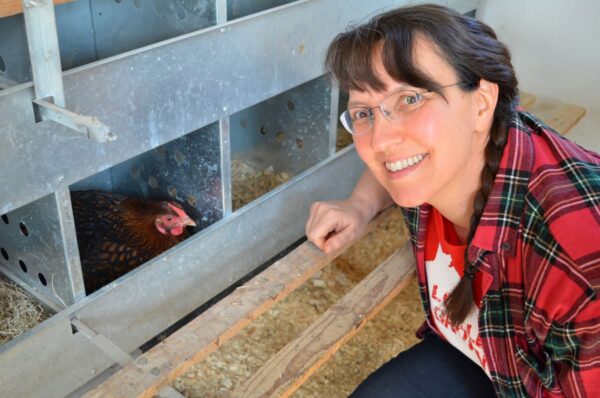
Keeping nest boxes clean and fresh means you rarely need to wash eggs, which saves time. (In wet conditions, the hens may still track mud into the nest boxes.) I like to add fresh herbs like sage, oregano, or wormwood to boxes to help deter mites and other pests. Dust bins or an outdoor dusting area help chickens maintain plumage and skin health.
It’s important to maintain good air flow in your chicken coop, and avoid dampness and mold. Chickens have sensitivity respiratory systems, and a musty coop can lead to health problems. If your coop is stinky, you need to change up your chicken care routine.
We use the deep litter method, adding or flipping bedding as needed to keep it composting. With small flocks, you can spot clean droppings with a cat litter scooper instead of replacing all the bedding.
Remember, chicken droppings need to be composted before adding them to the garden. The dropping are high in nitrogen, and can burn plants or potentially spread disease if applied fresh. See “Composting 101” for tips on managing your compost.
Are you ready to start raising chickens?
Remember, you don’t need a chicken palace to keep a few laying hens. Just cover the basics, and you’ll be on your way to a happy, healthy flock.
To take your flock care to the next level, check out, “50 Do-It-Yourself Projects for Keeping Chickens“. This handy book includes handy ideas such as forage planters and chicken first aid. Enjoy your backyard chicken adventure!


This article is by Laurie Neverman. Laurie grew up on a small dairy farm in northwest Wisconsin, and now lives on a 35 acre homestead in northeast Wisconsin. Their family raises meat chickens, laying hens, and ducks. They use solar water heating and line drying, root cellaring and freeze drying, annual gardens and permaculture.
[ad_2]
Source link
Get more stuff like this
in your inbox
Don't Be Left Unprepared
Thank you for subscribing.
Something went wrong.






